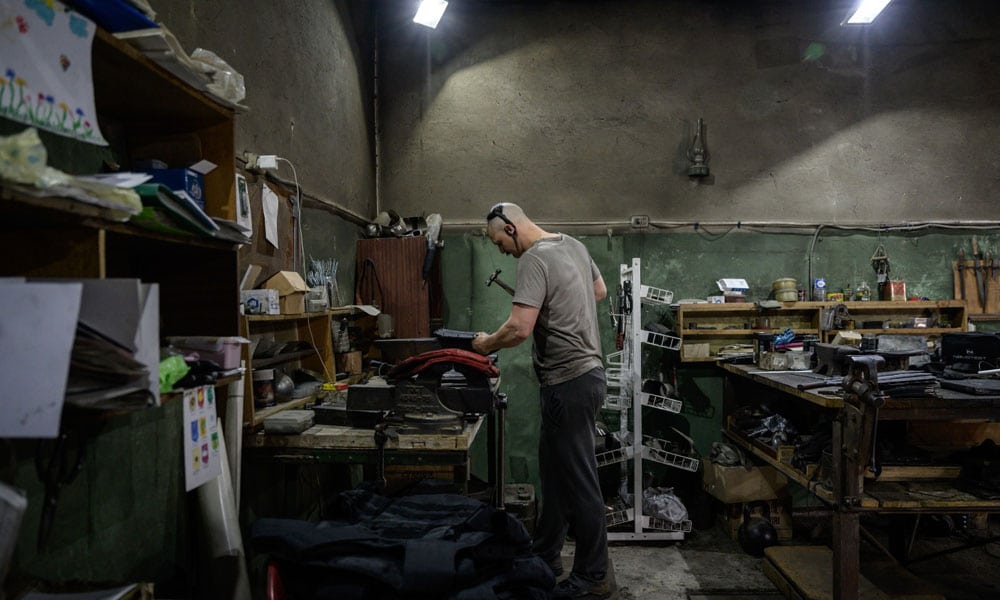Zaporizhzhia, Ukraine: Ukrainian armour-maker Vadim Mirnichenko used to specialise in swords and breastplates for medieval jousting competitions -- but after Russia invaded his homeland, he turned his passion for historical weaponry to the modern day. The small, dark workshop of the medieval combat enthusiast and self-taught blacksmith is full of swords and blades at various stages of manufacture, and designs for different pieces of armour.
A mannequin sporting metal shoulder plates stands forgotten in the corner as the craftsmen switch their attention to bullet-proof plates that can be fitted into fighters' vests.
Mirnichenko, an imposing figure with a shaven head, has 20 years of medieval combat tournament experience, with several broken ribs to show for it. "It's a brutal sport," the 39-year-old tells AFP, but "like every man, I want to hold a sword in my hand, and to fight like a knight".
Medieval combat is a discipline that ranks as sport in Ukraine, which hosted the 2019 world championships just 100 kilometres (60 miles) or so from Kyiv. More than a thousand competitors from across Europe, and even as far away as Australia, arrived to prove themselves in jousts on horseback and on foot.
And Mirnichenko earned enough to make a living out of his hobby.
International clientele
Before the coronavirus pandemic shut down tournaments, he employed up to 16 people in his workshop in the southern city of Zaporizhzhia. He even counted international customers among his clientele -- when AFP visited the workshop, a shipment of metal plates was being readied to be expedited to China.
Nowadays, though, the workers' focus is much closer to home. "I am very proud that we are doing our part to help our country," says his friend and fellow craftsman, Andriy Paliy.
Mirnichenko says that, despite his tactical training, he was turned down by the Ukrainian army, so he decided to use his expertise in metalwork to help the war effort.
"One day, a friend and I decided to test our work -- our swords and our scythes," he says. "So we went to a shooting range and it turned out that our armour could stop the ammunition."
To make the protective gear, Mirnichenko and his team rivet steel plates together over different layers of foam, before covering them with a thick band of grey tape.
The first dozen, financed by donations from overseas clients, were given to friends in the army, police and defence forces. Around 30 others were sold at cost for $150 (140 euros) each.
They have been tested in the field, too, says Paliy, a similarly striking figure with his handlebar moustache and a long ponytail on one side of his head.
An acquaintance was wearing one of the plates when he found himself under Russian fire, and thanks to that "he is alive", except for a possible broken rib, Paliy says.
Mirnichenko says his business -- which still does not have a name -- should be able to produce around 30 more vests, before a lack of metal and cost constraints force them to turn to making knives and machetes.
Improving the design
But that has not stopped him trying to improve his design. On Sunday, Mirnichenko and Paliy were at the shooting range again to test two new prototypes comprising three finer plates rather than just two -- but this time some of the bullets pierced through.
"We know now that that wasn't a good idea," says Mirnichenko, unfazed. Over the last week, the first houses were bombed in Zaporizhzhia, now less than an hour from the front line of the fighting.
Bombing can now be heard in certain areas in the city.
Even though the Russian forces have apparently turned their attention to Ukraine's south, Mirnichenko has not yet evacuated his family. Pinned up in the grimy workshop next to the armour designs are a child's drawings -- a blue dinosaur, multi-coloured flowers and butterflies.
Mirnichenko said he is determined to keep his family safe. "No matter what happens to me," he says. -- AFP










